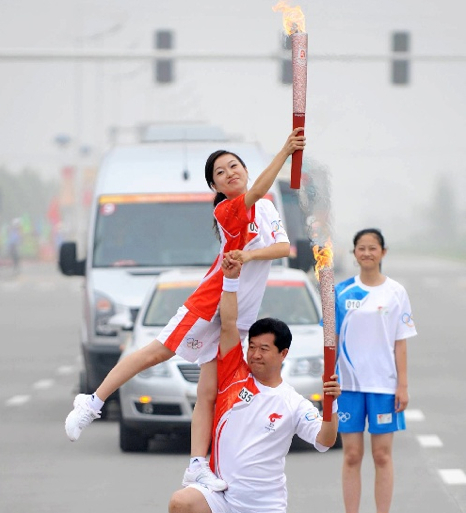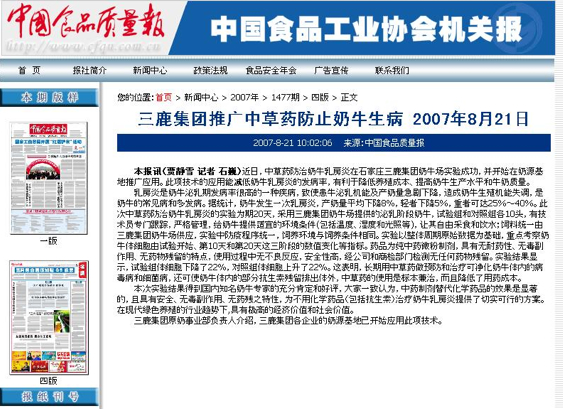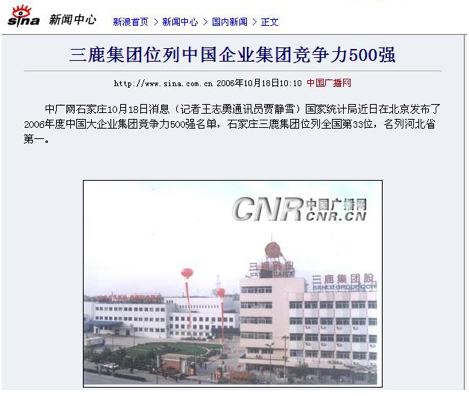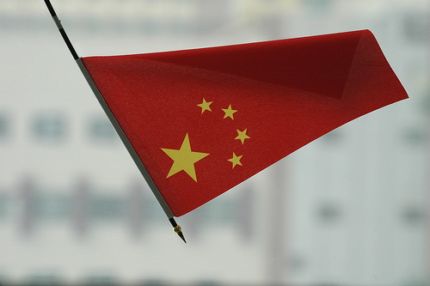Sanlu's public relations pawns: a relay of lies in China's media
By David Bandurski — In early August, as the stage was set for the Beijing Olympic Games and news about poisonous milk powder was being suppressed by corporations and officials, scores of print media and major Web portals across China ran a story about how the dairy brand Sanlu, now at the center of the dairy industry scandal, had been honored in an award campaign called “30 Years: Brands that Have Changed the Lives of Chinese.”
No one could have seen it so clearly then, but the “30 Years” award campaign, hosted by Huaxia Times in cooperation with China Central Television, Sina.com, China National Radio and other media organizations, was the plainest illustration of a media system gone horribly rotten, in which media are pushed to profit richly from falsehoods even as public interest news is systematically suppressed.
[ABOVE: Screenshot of Xinhua website coverage showing Sanlu PR manager Jia Jingxue (being held up) as an official bearer of the Olympic flame.]
The August 6 article reporting the “30 Years” honor bestowed on Sanlu was written by Miao Wanfu (苗万福) and appeared virtually everywhere — in scores of newspapers, at the website of the official People’s Daily, at Tianya, at Sina, and at a leading food industry website, to mention just a few.
And who is Miao Wanfu?
As the Oriental Daily and others have reported, Miao runs Sanlu’s internal public relations machine. But readers of the above “news” would never have guessed as much. Miao is identified — when a byline appears at all — as “correspondent Miao Wanfu” (通讯员苗万福).
On the People’s Daily website, Miao manages to come off as a staff reporter for the CCP’s top daily. And when the report runs subsequently at China’s leading food industry website it is attributed again to “correspondent Miao Wanfu.” We are told that the news comes from “People’s Daily Online.”
Misrepresentations of this sort are perpetuated across China’s media, where a lack of professional standards means “news” space is stuffed routinely with material from valuable advertising clients.
Here is “correspondent” Miao Wanfu again for People’s Daily Online, and for Hebei Daily. And here he is apparently reporting for the Central Propaganda Department’s Guangming Daily in June 2006 about the purchase of a stake in Sanlu by New Zealand’s Fronterra Group.
When Southern Metropolis Daily broached the topic last week of how Chinese media had contributed to the tragedy of China’s tainted milk crisis it was opening up a great big can of worms.
There are many hard and searching questions to answer. As the newspaper asked, why, before the breakthrough report by Oriental Daily journalist Jian Guangzhou (简光洲), did media suggest only that “certain brands” of milk powder had problems? And why, even as questions were beginning to surface about the safety of milk powder from Sanlu, were the company’s supposed contributions to the lives of ordinary Chinese being trumpeted so loudly.
Chinese media will not be given an opportunity to delve very deeply into these questions. The answers, after all, point to the ugliness of state media controls and the failure of media policy as well as to runaway commercial greed. The Chinese media’s role in the tainted milk crisis should remind us again just how poisonous the combination of rigorous press controls and unfettered commercialization can be.
Another Sanlu public relations manager, Jia Jingxue (贾静雪), is perhaps the best icon for the false messages drummed into the Chinese public about the company’s products even as news of life-and-death importance was being suppressed in the interest of corporate profits and China’s Olympic image.
As the Olympic torch — the “sacred flame,” as it was generally called in China’s media — made its way through the city of Shijiazhuang on July 30, Sanlu’s Jia Jingxue was official torch bearer number 36, right behind local cultural official Zhou Jian (周健), and the two of them struck the following memorable pose.
A simple Chinese-language search for “Jia Jingxue” makes it clear that she was one of the most prolific contributors to the relay of lies about Sanlu that were perpetuated throughout China’s media.
Take, for example, this August 2007 news report from China Food Quality News (中国食品质量报), the newspaper designated by China’s State Council as the primary vehicle for disseminating food quality and supervision policies and regulations.
The article, “Sanlu Group Promotes Use of Chinese Herbal Medicine to Prevent Illness Among Dairy Cows,” has a double byline that reads somewhat ambiguously: “China Food Quality News reporting (Jia Jingxuan reporter Shi Wei).”
While Chinese media insiders might understand that the odd placement of names before and after the title “reporter” suggests this is a corporate press release placed directly in the newspaper, ordinary readers would have no way of recognizing this. Jia Jingxue is effectively passed off as a staff reporter for China’s top newspaper devoted to issues of food quality and safety.
Why would China Food Quality News allow this to happen? Because Sanlu is as valuable as advertisers come.
For a glimpse at how profit-oriented this government-designated food quality mouthpiece has become, you need only visit their home page, a sloppy collage of corporate logos — Jiuhe Foods, Bright Dairy and Foods, Yurun, Wahaha, Shineway Group, and of course Sanlu, to name just a handful.
In July this year, just days before her participation in the Olympic torch relay, Jia Jingxue was writing for the local party daily in Shijiazhuang. The article appeared at several major Websites, including Sina.com, with a logo and link to Shijiazhuang Daily and a byline that read: “From this newspaper, Jia Jingxue reporting” (本报讯, 贾静雪).
On September 1, just two weeks before the scandal broke, Jia appeared as a reporter for the official Hebei Daily as well as the official Hebei Economic Daily. The article was called, “Sanlu is Honored with the Nation’s Only Science Progress Award for the Dairy Industry,” and it also appeared on the official Website of the Hebei provincial government.
The examples go on and on. As the screenshot below attests, the same Jia Jingxue has apparently also been a correspondent for the official China National Radio.
In sickening parallel to the quality problems plaguing other consumer products, examples like these are flagrant abuses of the trust of the Chinese media consumer. Poisonous milk has its parallel in poisonous media.
But the complicity of China’s media is doubly disturbing because it underlines a dangerous trend resulting directly from the party’s policy on media — an amplification of falsehood driven by the narrowest commercial ends attended by state news censorship that suppresses information that is critical to the well-being of ordinary Chinese.
As the tainted milk scandal shows only too clearly, this is a volatile combination.
Sanlu, no doubt, is just the tip of the iceberg. And unless the media are given greater freedom to monitor officials and corporations on behalf of the people, the cruel and cynical contrast between public relations ploys and hidden realities will persist.
Consider this chilling study in contrasts.
On August 12, a rosy piece of soft news on China’s top food quality website reported that Sanlu was generously giving free cases of milk powder to “Olympic babies” born on the first day of the Games.
The final line of the “news article” shouted out with exclamation points:
“Sanlu milk powder says ‘Let’s go!’ to the babies of the Olympics. Let’s use high-technology, high-standard and high-nutrition Sanlu milk powder to say ‘Let’s go!’ for the future of China!”
[Posted by David Bandurski, September 28, 2008, 2:15pm]






